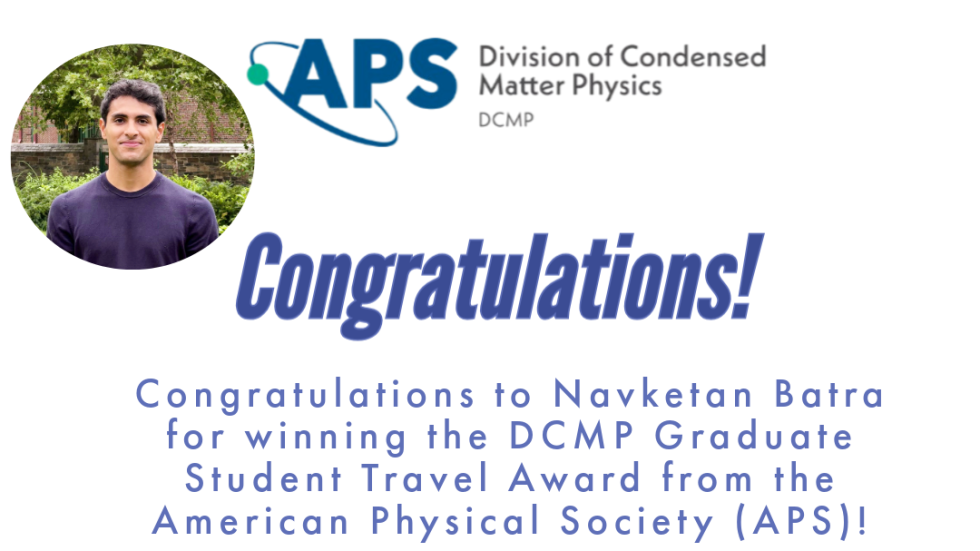The American Physical Society recently awarded Ph.D. student Navketan Batra a Division of Condensed Matter Physics (DCMP) Travel Award.
DCMP APS Global Physics Summit Graduate Student Travel Awards are available to assist graduate student researchers' professional development and careers. DCMP will award up to twenty DCMP Travel Awards of $800.00 to support graduate student members of DCMP to participate in the 2025 APS Global Physics Summit.
Congratulations, Nav!
Below, Navketan discusses the research impacted by this award.

The DCMP Graduate Student Travel Award from the American Physical Society (APS) will provide an excellent opportunity to present my research to a wider audience and potentially establish new collaborations.
Additionally, with the support of the Dissertation Fellowship Award from the Department of Physics, Brown University, my future research will focus on exploring these emerging platforms and developing novel methods to probe topological orders. The abundance of new data from these platforms presents both exciting possibilities and challenges that must be addressed to fully unlock the potential of topological matter.
A curious fact we all learned is that it is impossible to define a global system of single-valued coordinates on a sphere due to topological constraints. Unlike flat, two-dimensional planes where Cartesian coordinates can provide a seamless and consistent grid system, a sphere’s curved surface cannot be covered without introducing discontinuities or singularities. In other words, any attempt to define a continuous and consistent set of coordinates across the entire surface of a sphere will inevitably result in points where the coordinate system breaks down. For example, the poles do not have a well-defined meridian. However, if we choose a local system over a global system of single-valued coordinates, the task becomes as trivial as reading an atlas.
Now imagine covering the surface of a sphere with multipartite entangled particles, say electrons. If the particles are short-ranged entangled, we expect the behavior of a single particle to be affected by its local neighborhood. Stirringly, we also do not expect the physical properties of the local system to depend on the topology of the space on which the system exists, such as a sphere in our example. On the other hand, if the particles are long-range entangled, the global properties of the underlying space become crucial. In fractional quantum Hall phases, the electrons are long-range entangled. This means that the particles are able to sense a global scale, which in real materials is defined by the sample size. This is reminiscent of the curious properties and constraints the underlying topology puts on the system. Thus, the ordering of the constituent particles is aptly termed ‘Topological Order.’ This particle farsightedness leads to some remarkable properties of the phases, which is the central theme of my research.
The above paragraphs provide an intuitive picture. Nevertheless, the actual physics is much more complex. To make matters worse, as my adviser, Prof. Dima Feldman, says, physics is an experimental science. Therefore, the most critical challenge is ensuring that the theoretical framework indeed describes what is being measured. One of the fascinating consequences of topological order is the concept of fractionalization. The low energy description of a fractional quantum Hall state consists of particles that carry a fraction of an electron charge. This has been confirmed via shot noise experiments that definitively measure the fluctuations in electrical current carried by these fractional particles. However, experiments with higher sensitivity to probe more complex orders reported that the fractional charge grows at extremely low temperatures. Despite some theoretical attempts and experiments with more sophisticated sample geometry, the problem remained unsolved. In our efforts to unravel the long-standing problem, Dima and I developed a model [1] that explains the generation of excess noise at lower temperatures and provides a possible solution to the problem.
Apart from fractional charge, the low-energy quasiparticles also show fractional exchange statistics. Unlike the fundamental particles in the standard model, the quasiparticles, which are confined to two dimensions, are no longer limited to following Bose or Fermi statistics. Hence appropriately termed as ‘anyons’. In an actual sample, anyons are collective excitations in a phase of matter with a topological order. Unlike the local degrees of freedom, say a phonon, each anyon by themselves do not have a local Hilbert space attached with them. Instead, multiple anyons taken together form a Hilbert space due to their inherent global topological nature. Consequently, the worldlines of anyons braid around one another, opening up entirely new ways of storing and processing information. This fact has tremendous technological consequences, which has driven the research in the field of topological matter forward.
After careful efforts from talented people worldwide, the community has finally figured out and demonstrated different ways to directly measure anyone braiding in some of the simplest topological orders. As we advance, demonstrating the braiding properties in more complex states serves as one of the key motivations. More complex states, of course, come with more complex problems, theoretically and experimentally. Yet, the existing setups have limited sensitivity and face major challenges beyond the very simplest examples of topological order. With the help of a previous graduate student, Zezhu Wei, and a collaborator from the University of Illinois Urbana-Champaign, Prof. Smitha Vishweshwara, we utilized a new type of geometry [2] that inherently fixes the sensitivity issues and allows one to interpret the experimental data with theory straightforwardly. Additionally, anyons are not limited to electrical setups. Several spin systems are proposed to have topological order with neutral anyon excitations. In our efforts to extend the anyon braiding measurement techniques to systems that do not carry charge, we collaborated with Prof. Vesna Mitrovic and proposed an experimental protocol [3] to probe the exotic topological orders via thermal conductance measurements.
In recent years, the field of topological matter has experienced significant breakthroughs, including the stabilization of fractional Chern insulators at zero magnetic field in platforms ranging from twisted bilayer TMDs to multilayer graphene.
[1] N. Batra, D. E. Feldman, Phys. Rev. Lett. 132, 226601 (2024)
[2] N. Batra, Z. Wei, S. Vishweshwara, D. E. Feldman, Phys. Rev. B 108, L241302 (2023)
[3] Z. Wei, N. Batra, V. Mitrovi´c, D. E. Feldman, Phys. Rev. B 107, 104406 (2023)
